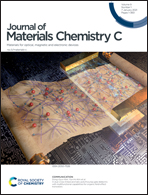Room temperature ferroelectricity and blue photoluminescence in zero dimensional organic lead iodine perovskites†
Abstract
Organic–inorganic hybrid perovskite materials have attracted great attention due to their great application potential in photovoltaics and optoelectronics. Among them, some 2D and 1D lead-iodide-based perovskites were found to exhibit ferroelectricity at room temperature. Yet, no 0D lead-iodide-based perovskites were reported to be room temperature ferroelectric. Here, we report a new lead-iodide-based perovskite material, (DMA)4PbI6, which is ferroelectric at room temperature. The spontaneous polarization of (DMA)4PbI6 is about 0.3 μC cm−2. (DMA)4PbI6 undergoes a ferroelectric–ferroelectric phase transition around 252 K in the heating process. The ferroelectric–ferroelectric phase transition is a first order phase transition with a hysteresis of 18 K between the heating process and the cooling process. The absorption spectra show that (DMA)4PbI6 is a direct band material with a band gap of 2.80 eV. A broadband blue photoluminescence centered at 2.7 eV was observed, which may be attributed to the self-trapped excitons.



 Please wait while we load your content...
Please wait while we load your content...